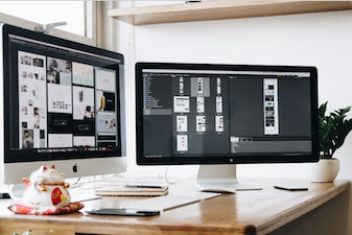For professional photographers, open source software like Linux is just what they need for processing images and keeping their workflow stable.Many photographers find themselves paying subscriptions to Lightroom or Adobe Photoshop year after year,without realizing that Linux offers software that is every bit as effective—and free.
Windows and Apple are still extremely popular. But the demand for other operating systems such as Linux is growing. Linux provides people with the tools they need in almost every industry, whether it is graphic design, photography, or game development.
Linux and distros – the basics
Linux is open-source software based on the Linux kernel. Other systems, namely Microsoft and Apple, come in one complete version. In contrast, Linux can adapt to satisfy the needs of the user through the addition of various free apps.
Distributions, also known as distros, are free operating systems originating from the Linux kernel that you can install on your PC or mobile device. A distro often incorporates a package management system, which facilitates speedy installation, configuration, and necessary upgrades. This does away with the process of having to find software online and manually install it on your Microsoft or Apple device.
A Linux distro contains the Linux kernel and a variety of software, including GNU tools, a window system and manager, and a desktop environment. These elements combine to produce a software package that is adaptable and allows users to install the specific apps and operating systems that they need.
Read: How to Write an Effective Creative Brief for Graphic Designers
What do photographers need?
Apart from hardware—a camera, flash, remote etc.—photographers need software to process their photos and a workflow to enable that task. There are many Linux distros that provide users with just that.
Now is a good time to get up to speed on one of the best software around.
Desktop environments and window managers
Without a window manager, you won’t be able to use any Linux distros. Window managers take care of what you see on your screen in terms of images—art and photography. The other essential element is the desktop environment, which is in charge of the rest of your PC’s interface, such as icons, the structure of menus, their appearance, and so on.
A few examples of desktop environments and windows managers are:
- Awesome WM
- Gnome
- XFCE
Operating systems for photographers: the basics
Gnome Color Manager
Photographers need to calibrate their monitors to ensure that the colors they see on the monitor are accurate.
Rapid Photo Downloader
To work with your images, you need to transfer them from camera to computer. Rapid Photo Downloader is the perfect tool to expedite this process.
gThumb
Professional photographers especially always need to embed metadata in their pictures, such as keywords, copyright information, and photographer credit. This app comes from Ubuntu repositories and is an excellent tool for all creative artists.
Distros that work for photographers: some examples
Linux Mint Cinnamon
Linux Mint Cinnamon is a free distro that works well for photographers who want a user-friendly, stable and reliable operating system that supports their workflow. In general, computer users find Linux Mint accessible and as good as Microsoft Windows or Apple. While Cinnamon offers a system that is compatible with many other distros. That specific flavor can get turned into a full desktop that is a pleasure to use.
Read: The structure of Linux operating system
GIMP (GNU Image Manipulation Program)
This is a first-class image editor in the eyes of many creators, especially photographers. Photoshop is great, but those who opt for GIMP get all the same tools without having to fork out a huge amount of cash.
Gimp can open PSD files and is perfect for processing and manipulating photos, as well as being a decent graphic design tool. Files can be saved in many different formats. GIMP works with Linux, Windows and macOS.
Ubuntu Studio
Ubuntu Studio is one of Linux’s more well-known distros. Many artists and photographers find it an excellent overall choice for facilitating the creative process. The free open-source software allows you to import photos, process them, and store them in a user-friendly and accessible way. Ubuntu Studio is customized for artists, photographers, and other content creators, making it a better choice than the original/basic Ubuntu.
One thing to watch out for: Ubuntu requires better and more powerful hardware, while other options, like Linux Mint, can work with older hardware. Different versions of Ubuntu come with different applications, such as the option to calibrate color on your monitor.
Darktable
This workflow app and photo editing software has all the features that photographers need. Darktable releases new versions regularly to keep up with the needs of artists, including professional photographers. It features many advanced photo-editing tools, export support and format conversion.
RawTherapee
This operating system is a comprehensive bundle of tools that allows photographers to create presets and process images. When you compare RawTherapee to other systems such as Adobe Photoshop or Lightroom, it provides all the functionality without the cost.
Antergos
This distro comes with a wide range of programs and is similar to Arch Linux, but includes a visual installer to make the process a bit easier. One big plus for using Antergos is that you can perform updates as and when you need them, rather than doing much larger ones at longer intervals.
Rawstudio
Rawstudio is one of the best open-source programs when it comes to working with RAW images. A tool that is absolutely essential for photographers. It also facilitates the process of working with large batches of images rather than having to go through each one individually, as well as being able to convert RAW files into TIF, JPEG, or PNG formats.
Read: How to run Windows software on Linux
Spoilt for choice
Many people’s only complaint about Linux is that there is too much to choose from. This might be accurate, but if that’s a downside to software, it’s not a terrible one.
When you’re looking for quality tools to enhance your photography, the chance to use the best software is impossible to overstate. Especially if that software not only allows you to edit images but to manage other aspects of your photography business too.
You may need to do some research and play around, but Linux offers everything a photographer needs to create professional images—without a hefty price tag.
If you like the content, we would appreciate your support by buying us a coffee. Thank you so much for your visit and support.




Thanks for this! I’m thinking about installing the Linux Distro – Fedora Design Suite. What do you think of that one for general image editing purposes?
Thanks